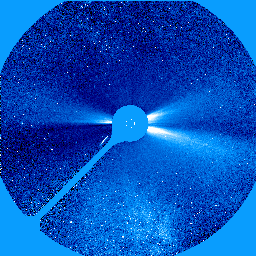Solar Physics
|
The Solar group at Birmingham has an interest in the Sun's atmosphere right from the solar surface out to many astronomical units. This has led to the involvement in a large number of space missions. As well as access to data from the Solar Maximum Mission and the YOHKOH X-ray solar telescope, the group has been heavily involved in both building, and now in analysing the data, from several instruments which are currently operations. The current instruments are:
Further information is available on: |
||||||
|
||||||
This false colour image is from the Large Angle Spectrometric Coronagraph (LASCO) aboard the SOHO spacecraft. It shows an image of the sky with the Sun at the centre, but the direct sunlight is blocked. The image covers an angular size of 30°, which is similar to the size of the Orion constellation. LASCO can see stars about 100 times fainter than the human eye and the milky way is easily seen at the bottom of the image. On the left, close to the blocking disk, a comet can be seen heading towards the Sun, it was not seen on the other side and is thought to have been destroyed in the solar atmosphere. However, of most interest to solar astronomers are the bright structures pointing away from the Sun. These streamers are part of the Sun's outer atmosphere and by studying their behaviour and the way they change with time LASCO is able to address some of the many still unanswered questions about our Sun. | ||||||





